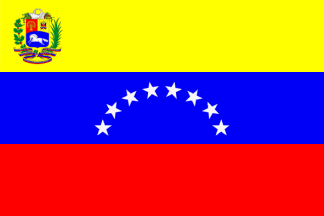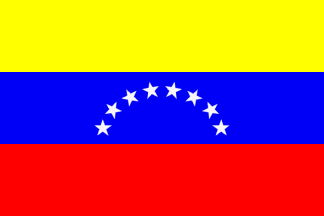 (2:3)
(2:3) 
National and State Flag
image by Pascal Gross, 13 March 2006

Last modified: 2015-08-13 by zoltán horváth
Keywords: venezuela | america | bolivar | star |
Links: FOTW homepage |
search |
disclaimer and copyright |
write us |
mirrors
 (2:3)
(2:3) 
National and State Flag
image by Pascal Gross, 13 March 2006
 (2:3)
(2:3) 
"Civil" Flag
image by Pascal Gross, 13 March 2006
Official Name: Bolivarian Republic of
Venezuela (República Bolivariana de Venezuela)
Capital: Caracas
Location: South America
Government Type: Federal Republic
Flag adopted: 12
March 2006
ISO Code: VE
See also:
From Agence France Presse, November 13, 1999 :
"Venezuela changes name to "Bolivarian Republic
of Venezuela"
Venezuela's Constitutional Assembly on Friday approved a name
change for the country, which in the future will be called the
Bolivarian Republic of Venezuela.
Venezuelan President Hugo Chavez has said the name change was an
essential part of his "revolutionary project" to change
the country's constitution.
"Bolivarian" referes to revolutionary figure and
national hero Simon Bolivar.
Members of a style commission agreed the text of the name change,
although it has not yet been decided when the name change would
go into effect. "
David Fowler , 14 November 1999
Venezuela has, if the people give a YES vote to this
Constitutional change and a new name: República Bolivariana de
Venezuela. However, the Flag will remain the same.
Guillermo Aveledo , 14 November 1999
at <www.ucab.edu.ve> (defunct) one finds:
"Our flag is made up of three horizontal stripes of equal
width. Yellow stands for the richnesses of the territory, blue
for the sea separating us from Spain and red for the blood shed
by our patriots during the Independence [War].
Our national flag was brought by General Francisco de Miranda in
his second expedition on March 12th, 1806 into "Vela de
Coro" ; this is why the Flag Day is held on March 12th. It
was recognised as national standard by Congress on July 15th,
1811 and was firstly hoisted as such on July 14th that
year."
Santiago Dotor , 30 December 1998
Coro, which is the oldest city in the mainland of Venezuela,
is directly on the shoreline. A lookout post was placed north of
the city, and was named "La Vela de Coro", literally
"The watch over Coro". The Spanish word
"vela" can both mean sail and vigil. This later is the
correct sense of this word, the place where the vigil, the watch,
took place.
Ricardo Kowalski, 15 September 1999
Flags in Venezuela are made in a very informal, quite crafty
way. As far as I know, There isn't any official guideline or
chart for the construction of the national flag, so there are
flags with smaller stars, narrower archs, longer stripes,
different colours.In the current constitution, it says, about the
flag, that this is the tricolori of yellow, blue and red.
Plain and simple. Not much further explanatios are set in the law
of National Symbols.
Guillermo Tell, 5 November 1999
No official shades have been issued with regard to either the
stripes or the arms, and no recommendations for the arms are
given in any official source. However, the UK Flag
Institute give yellow PMS 109C, blue PMS 280C and red 032C, BR20:
Yellow, red PMS 186C and blue PMS 280C, and the Album des
Pavillons yellow 116C, blue 286C and red 186C.
Christopher Southworth, 4 Maech 2005
Translated from From <www.asambleanacional.gov.ve>:
"Article 3. The National Flag is inspired by the flag
adopted by the Congress of the Republic in 1811. It
consists of the colors yellow, blue and red, in united, equal and
horizontal stripes, in the preceding order from top to bottom,
and, in the midst of the blue stripe, eight five-pointed white
stars placed in an upwardly convex arc of a circle. The National
Flag used by the Presidency of the Republic and by the National
Armed Forces, as well as those hoisted upon national, state, and
municipal public buildings, shall include the Coat of Arms of the
Bolivarian Republic of Venezuela at the edge of the yellow stripe
near the hoist. The National Flag used by the Merchant
marine shall bear only the eight stars.
Eugene Ipavec, 9 March 2006
The 2006 Flags are based on drawings available at <www.asambleanacional.gov.ve>.
Pascal Fross, 13
"Miranda gave at least two sources of inspiration for his flag. In a letter
written to Count Semyon Vorontsov in 1792, Miranda stated that the colors were
based on a theory of primary colors given to him by the German writer and
philosopher Johann Wolfgang von Goethe. Miranda described a late-night
conversation he had with Goethe at a party in Weimar during the winter of 1785.
Fascinated with Miranda's account of his exploits in the United States
Revolutionary War and his travels throughout the Americas and Europe, Goethe
told him that, "Your destiny is to create in your land a place where primary
colors are not distorted." He proceeded to clarify what he meant by this:
First he explained to me the way the iris transforms light into the three
primary colors […] then he proved to me why yellow is the most warm, noble and
closest to [white] light; why blue is that mix of excitement and serenity, a
distance that evokes shadows; and why red is the exaltation of yellow and blue,
the synthesis, the vanishing of light into shadow. It is not that the world is
made of yellows, blues and reds; it is that in this manner, as if in an infinite
combination of these three colors, we human beings see it. […] A country [Goethe
concluded] starts out from a name and a flag, and it then becomes them, just as
a man fulfils his destiny."
Daniel Aarhus, 23 July 2013
Very interesting writing. I've heard and read the story behind Miranda's
creation of the first tricolor flag of Venezuela (which would, in turn, be
adopted by Colombia and Ecuador as their national colors). However I hadn't
heard the full story, so I believe it should be added to the Venezuelan,
Colombian and Ecuadorian pages
respectively, as they all share the same flag.
Esteban Rivera, 04 August 2013
The protocol manual for the
London 2012 Olympics
(Flags and Anthems Manual
London 2012 [loc12]) provides recommendations
for national flag designs. Each
NOC
was sent an image of the flag, including the
PMS shades, for their approval by LOCOG. Once this was obtained, LOCOG produced
a 60 x 90 cm version of the flag for further approval. So, while these specs may
not be the official, government, version of each flag, they are certainly what
the NOC
believed the flag to be.
For Venezuela: PMS 102 yellow, 293 blue, 032 red, 355 green and black. The
vertical flag is simply the horizontal version turned 90 degrees clockwise.
Ian Sumner, 10 October 2012
By decree signed on 3 July 1963, President of the Republic of
Venezuela Rómulo Betancourt prescribed the 12th March as the
Flag Day (Día de la Bandera).
This Day commemorates 12 March 1806, when Miranda hoisted for the
first time the flag of freedom on the vessel "Leandro",
in the bay of Jacmel in Haiti, and Miranda's first revolutionary
expedition. This Day has to be historically considered
with 3 August 1806, the day Miranda hoisted the flag for the
first time on the territory of Venezuela, and on Sunday 14 July
1811, the day when Prudencio and José María, the
sons José María España, hoisted for the first time on the
great square of Caracas the Tricolor flag selected by the
Constituent Assembly (Congreso Constituyente).
Source: Rafael Marrón González, Venezolanidad -
Venezuela en mil preguntas (LXXXVIII) "Correo
del Caroní", 12 November 2005.
The 1806 events are described with more details on Venezuela - Historical Flags.
Ivan Sache, 20 November 2005
On 21 August 2006, the Council of the Ministers of Venezuela
approved the Decree prescribing the change of the National Flag
Day from the 12 March for the 3 August. The change was required
by President of the Republic Hugo Chávez, in order to celebrate
the national flag on the day when Francisco de Miranda hoisted
the national tricolor flag on the Venezuelan land for the first
time, on 3 August 1806.
Source: El
Universal, 22 August 2006.
Ivan Sache, 4 September 2006
See here
photo of erroneous
Venezuelan flag, with stars upside down. Other flag visible on
photo are flag of Lara state and Palavecino municipality.
Aleksandar Nemet, 10 February 2010
The 2010 Miss Universe contest, held on 23 August in Las Vegas (USA), caused
a big fuss in Venezuela. During the ceremony, Stefania Fernández, Miss Universe
2009, "abandoned" her crown and waved her national flag. Everyone in Venezuela
immediately noticed that the flag had seven stars, that is, matched the flag
used until 2006 and changed for the flag with eight star upon request by
President Chávez. The "blunder" was perceived as a political message and a
support to the opposition, since general elections were scheduled one month
later. Ironically enough, Stefania Fernández appeared one year before in the
2009 Miss Universe gala wearing a red dress, which was perceived by some as a
support to Chávez.
Photo and video:
http://venezuelatina.com/2010/08/29/miss-univers-et-les-sept-etoiles/
Ivan Sache, 12 May 2012
On 13 May 2012, fans of car races watched on TV Pastor Maldonado winning the
F1 Spanish Grand Prix, ran on the Circuit of Catalunya, Barcelona. The first win
ever in F1 by a pilot from Venezuela was celebrated with a flag blunder; during
the medal ceremony, the flag of Venezuela raised over the stand had seven
instead of eight stars. The blunder caused a great stir, especially in
Venezuela, so that the FIA issued a press release acknowledging the blunder and
promising it won't happen again.
Photo:
http://www.laverdad.com/deportes/2308-la-fia-se-disculpa-por-bandera-de-siete-estrellas.html
Ivan Sache, 22 May 2012
A few days ago, the Palestinian government named a street in Ramallah after
Hugo Chavez (a great supporter of theirs). A Venezuelan flag was hung from the
street sign, perhaps only for the ceremony, but, ironically for an event
honoring Chavez, it seems to have been the seven-star version. (Probably pulled
out of storage.)
Nachum Lamm, 22 June 2013